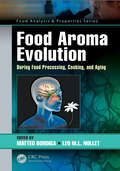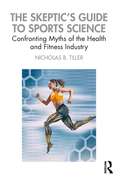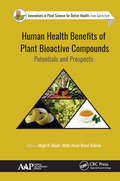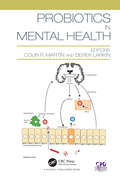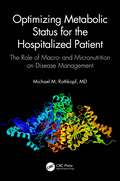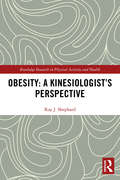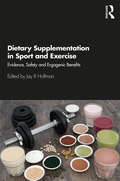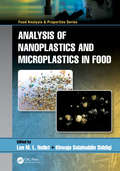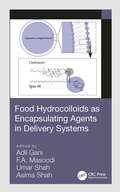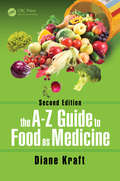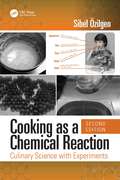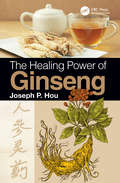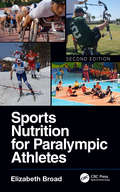- Table View
- List View
Food Aroma Evolution: During Food Processing, Cooking, and Aging (Food Analysis & Properties)
by Matteo Bordiga, Leo M.L. NolletOf the five senses, smell is the most direct and food aromas are the key drivers of our flavor experience. They are crucial for the synergy of food and drinks. Up to 80% of what we call taste is actually aroma. Food Aroma Evolution: During Food Processing, Cooking, and Aging focuses on the description of the aroma evolution in several food matrices. Not only cooking, but also processing (such as fermentation) and aging are responsible for food aroma evolution. A comprehensive evaluation of foods requires that analytical techniques keep pace with the available technology. As a result, a major objective in the chemistry of food aroma is concerned with the application and continual development of analytical methods. This particularly important aspect is discussed in depth in a dedicated section of the book. Features Covers aromatic evolution of food as it is affected by treatment Focuses on food processing, cooking, and aging Describes both classic and new analytical techniques Explains how the flavor perception results are influenced by other food constituents The book comprises a good mix of referenced research with practical applications, also reporting case studies of these various applications of novel technologies. This text represents a comprehensive reference book for students, educators, researchers, food processors, and food industry personnel providing an up-to-date insight. The range of techniques and materials covered provides engineers and scientists working in the food industry with a valuable resource for their work. Also available in the Food Analysis & Properties Series: Ambient Mass Spectroscopy Techniques in Food and the Environment, edited by Leo M.L. Nollet and Basil K. Munjanja (ISBN: 9781138505568) Hyperspectral Imaging Analysis and Applications for Food Quality, edited by N.C. Basantia, Leo M.L. Nollet, and Mohammed Kamruzzaman (ISBN: 9781138630796) Fingerprinting Techniques in Food Authentication and Traceability, edited by Khwaja Salahuddin Siddiqi and Leo M.L. Nollet (ISBN: 9781138197671) For a complete list of books in this series, please visit our website at: www.crcpress.com/Food-Analysis--Properties/book-series/CRCFOODANPRO
Food Aroma Evolution: During Food Processing, Cooking, and Aging (Food Analysis & Properties)
by Matteo Bordiga Leo M. L. NolletOf the five senses, smell is the most direct and food aromas are the key drivers of our flavor experience. They are crucial for the synergy of food and drinks. Up to 80% of what we call taste is actually aroma. Food Aroma Evolution: During Food Processing, Cooking, and Aging focuses on the description of the aroma evolution in several food matrices. Not only cooking, but also processing (such as fermentation) and aging are responsible for food aroma evolution. A comprehensive evaluation of foods requires that analytical techniques keep pace with the available technology. As a result, a major objective in the chemistry of food aroma is concerned with the application and continual development of analytical methods. This particularly important aspect is discussed in depth in a dedicated section of the book. Features Covers aromatic evolution of food as it is affected by treatment Focuses on food processing, cooking, and aging Describes both classic and new analytical techniques Explains how the flavor perception results are influenced by other food constituents The book comprises a good mix of referenced research with practical applications, also reporting case studies of these various applications of novel technologies. This text represents a comprehensive reference book for students, educators, researchers, food processors, and food industry personnel providing an up-to-date insight. The range of techniques and materials covered provides engineers and scientists working in the food industry with a valuable resource for their work. Also available in the Food Analysis & Properties Series: Ambient Mass Spectroscopy Techniques in Food and the Environment, edited by Leo M.L. Nollet and Basil K. Munjanja (ISBN: 9781138505568) Hyperspectral Imaging Analysis and Applications for Food Quality, edited by N.C. Basantia, Leo M.L. Nollet, and Mohammed Kamruzzaman (ISBN: 9781138630796) Fingerprinting Techniques in Food Authentication and Traceability, edited by Khwaja Salahuddin Siddiqi and Leo M.L. Nollet (ISBN: 9781138197671) For a complete list of books in this series, please visit our website at: www.crcpress.com/Food-Analysis--Properties/book-series/CRCFOODANPRO
The Skeptic's Guide to Sports Science: Confronting Myths of the Health and Fitness Industry
by Nicholas B. TillerThe global health and fitness industry is worth an estimated $4 trillion. We spend $90 billion each year on health club memberships and $100 billion each year on dietary supplements. In such an industrial climate, lax regulations on the products we are sold (supplements, fad-diets, training programs, gadgets, and garments) result in marketing campaigns underpinned by strong claims and weak evidence. Moreover, our critical faculties are ill-suited to a culture characterized by fake news, social media, misinformation, and bad science. We have become walking, talking prey to 21st-Century Snake Oil salesmen. In The Skeptic’s Guide to Sports Science, Nicholas B. Tiller confronts the claims behind the products and the evidence behind the claims. The author discusses what might be wrong with the sales pitch, the glossy magazine advert, and the celebrity endorsements that our heuristically-wired brains find so innately attractive. Tiller also explores the appeal of the one quick fix, the fallacious arguments that are a mainstay of product advertising, and the critical steps we must take in retraining our minds to navigate the pitfalls of the modern consumerist culture. This informative and accessible volume pulls no punches in scrutinizing the plausibility of, and evidence for, the most popular sports products and practices on the market. Readers are encouraged to confront their conceptualizations of the industry and, by the book’s end, they will have acquired the skills necessary to independently judge the effectiveness of sports-related products. This treatise on the commercialization of science in sport and exercise is a must-read for exercisers, athletes, students, and practitioners who hope to retain their intellectual integrity in a lucrative health and fitness industry that is spiraling out-of-control.
The Skeptic's Guide to Sports Science: Confronting Myths of the Health and Fitness Industry
by Nicholas B. TillerThe global health and fitness industry is worth an estimated $4 trillion. We spend $90 billion each year on health club memberships and $100 billion each year on dietary supplements. In such an industrial climate, lax regulations on the products we are sold (supplements, fad-diets, training programs, gadgets, and garments) result in marketing campaigns underpinned by strong claims and weak evidence. Moreover, our critical faculties are ill-suited to a culture characterized by fake news, social media, misinformation, and bad science. We have become walking, talking prey to 21st-Century Snake Oil salesmen. In The Skeptic’s Guide to Sports Science, Nicholas B. Tiller confronts the claims behind the products and the evidence behind the claims. The author discusses what might be wrong with the sales pitch, the glossy magazine advert, and the celebrity endorsements that our heuristically-wired brains find so innately attractive. Tiller also explores the appeal of the one quick fix, the fallacious arguments that are a mainstay of product advertising, and the critical steps we must take in retraining our minds to navigate the pitfalls of the modern consumerist culture. This informative and accessible volume pulls no punches in scrutinizing the plausibility of, and evidence for, the most popular sports products and practices on the market. Readers are encouraged to confront their conceptualizations of the industry and, by the book’s end, they will have acquired the skills necessary to independently judge the effectiveness of sports-related products. This treatise on the commercialization of science in sport and exercise is a must-read for exercisers, athletes, students, and practitioners who hope to retain their intellectual integrity in a lucrative health and fitness industry that is spiraling out-of-control.
Human Health Benefits of Plant Bioactive Compounds: Potentials and Prospects (Innovations in Plant Science for Better Health)
by Megh R. Goyal Hafiz Ansar Rasul SuleriaFocusing on the importance of functional foods and their secondary metabolites for human health, this volume presents new insights with scientific evidence on the use of functional foods in the treatment of certain diseases. The plants covered and their bioactive compounds are easily accessible and are believed to be effective with fewer side effects in comparison with modern drugs in the treatment of different diseases. The plants contain chemical compounds that can modify and modulate biological systems, eliciting therapeutic effects. Some plants and derived products mentioned include black carrot, olive oil, citrus peel, grapes, candy leaf, cereals and grains, and green and black tea. The volume is divided into four sections that cover these topics: Functional foods for human health: the available sources, biochemistry, structural composition, and different biological activities, especially antioxidant activity. Pharmacological aspects of fruits and vegetables: the extraction of bioactive molecules, phytochemistry, and biological activities of a selection of plants. Pharmacological aspects of natural products: bioactive compounds, structural attributes, bioactivity of anthocyanin, piceatannol, and a review of the ethnobotany and medicinal properties of green and black tea. Pharmacological aspects of cereals and grains: the health benefits of flaxseed, wheatgrass juice, and use and therapeutic potential as supplements for disease management.
Human Health Benefits of Plant Bioactive Compounds: Potentials and Prospects (Innovations in Plant Science for Better Health)
by Megh R. Goyal Hafiz Ansar Hafiz Ansar Rasul SuleriaFocusing on the importance of functional foods and their secondary metabolites for human health, this volume presents new insights with scientific evidence on the use of functional foods in the treatment of certain diseases. The plants covered and their bioactive compounds are easily accessible and are believed to be effective with fewer side effects in comparison with modern drugs in the treatment of different diseases. The plants contain chemical compounds that can modify and modulate biological systems, eliciting therapeutic effects. Some plants and derived products mentioned include black carrot, olive oil, citrus peel, grapes, candy leaf, cereals and grains, and green and black tea. The volume is divided into four sections that cover these topics: Functional foods for human health: the available sources, biochemistry, structural composition, and different biological activities, especially antioxidant activity. Pharmacological aspects of fruits and vegetables: the extraction of bioactive molecules, phytochemistry, and biological activities of a selection of plants. Pharmacological aspects of natural products: bioactive compounds, structural attributes, bioactivity of anthocyanin, piceatannol, and a review of the ethnobotany and medicinal properties of green and black tea. Pharmacological aspects of cereals and grains: the health benefits of flaxseed, wheatgrass juice, and use and therapeutic potential as supplements for disease management.
Probiotics in Mental Health
by Martin Colin R Derek LarkinThe concept that the gut and brain are intricately linked is widely accepted not just within the lay community but increasingly within scientific and therapeutic circles as well. Terms such as "heartache" and "gut wrenching" are more than mere metaphor, they represent key fundamental aspects of human experience which all individuals will invariably endure from time to time. The relationship between the gut and brain is complex but fundamental to health and wellbeing. Increasing and compelling evidence supports the existence of a relationship between the health and status of the gut and the manifestation of significant psychopathology. Uniquely within the field of mental health and psychiatry, the role of gut flora and probiotics in both the understanding and treatment of mental illness represents an emerging science whether the potential for therapeutic intervention, through the use of probiotics, offers an opportunity to determine efficacy within a coherent evidence-based model of both action and pathology or, moreover, offers interventions that are comparatively benign compared to the side-effect profile associated with most drugs used to treat mental illness. Probiotics in Mental Health examines the role of probiotics in a range of clinical presentations associated with significant psychopathology and facilitates a reconsideration of how mental illness may be conceptualised within a coherent gut-brain model of health and wellbeing. Under the rubric of enhancing wellbeing rather than dwelling on illness and disease, this exciting new volume not only comprises the latest evidence in the field but also advocates an approach characterised by the understanding of mental disorder within an evidence-based model and the pursuit of mental health and wellbeing through the most benign of interventions.
Optimizing Metabolic Status for the Hospitalized Patient: The Role of Macro- and Micronutrition on Disease Management
by Michael M. Rothkopf, MD, FACP, FACN Jennifer C. JohnsonThis book is a guide for clinicians seeking to use metabolic approaches in the care of hospitalized patients. Since a nutritional component exists for practically any disease process managed, it is important to properly address the macro- and micronutrient issues that can help facilitate a favourable clinical outcome. Metabolic medicine is a newly recognized speciality that applies proven nutritional approaches to support hospitalized patients within existing standards of care. Optimizing Metabolic Status for the Hospitalized Patient: The Role of Macro- and Micronutrition on Disease Management addresses the gap of nutrition knowledge among physicians who generally care for patients without addressing the nutritional and metabolic perspective. Features: · State-of-the-art guidelines for practicing metabolic medicine in the hospital setting. · “Hands on” guide for day-to-day metabolic management of hospitalized patients. · Personal insights from one of the field’s leading practitioners, drawing upon decades of experience. · Historical reviews of key scientific developments. This book is written by Dr Michael M. Rothkopf, Clinical Professor of Medicine at Rutgers/New Jersey Medical School. Dr Rothkopf founded the Metabolic Medicine Center at Morristown Medical Center and is the current Metabolic Medicine Consultant for the Heart Transplant, Lung Transplant, Cardiac Surgery and Wound Care Programs at RWJBH/Newark Beth Israel Medical Center. This book is directed at the physician level of hospital care. It provides value to a broad range of physicians regardless of their medical specialty or subspecialty. It will also be useful for medical students and resident physicians in training as well as nurse practitioners and physician assistants working in hospital settings.
Optimizing Metabolic Status for the Hospitalized Patient: The Role of Macro- and Micronutrition on Disease Management
by Michael M. Rothkopf, MD, FACP, FACN Jennifer C. JohnsonThis book is a guide for clinicians seeking to use metabolic approaches in the care of hospitalized patients. Since a nutritional component exists for practically any disease process managed, it is important to properly address the macro- and micronutrient issues that can help facilitate a favourable clinical outcome. Metabolic medicine is a newly recognized speciality that applies proven nutritional approaches to support hospitalized patients within existing standards of care. Optimizing Metabolic Status for the Hospitalized Patient: The Role of Macro- and Micronutrition on Disease Management addresses the gap of nutrition knowledge among physicians who generally care for patients without addressing the nutritional and metabolic perspective. Features: · State-of-the-art guidelines for practicing metabolic medicine in the hospital setting. · “Hands on” guide for day-to-day metabolic management of hospitalized patients. · Personal insights from one of the field’s leading practitioners, drawing upon decades of experience. · Historical reviews of key scientific developments. This book is written by Dr Michael M. Rothkopf, Clinical Professor of Medicine at Rutgers/New Jersey Medical School. Dr Rothkopf founded the Metabolic Medicine Center at Morristown Medical Center and is the current Metabolic Medicine Consultant for the Heart Transplant, Lung Transplant, Cardiac Surgery and Wound Care Programs at RWJBH/Newark Beth Israel Medical Center. This book is directed at the physician level of hospital care. It provides value to a broad range of physicians regardless of their medical specialty or subspecialty. It will also be useful for medical students and resident physicians in training as well as nurse practitioners and physician assistants working in hospital settings.
Obesity: A Kinesiology Perspective (Routledge Research in Physical Activity and Health)
by Roy J. ShephardThere have been many books written on the subject of obesity, but most have approached the topic from the standpoint of the nutritionist, concluding from the somewhat fallacious evidence of changes in body mass that exercise has little place in the prevention or the treatment of obesity. This new volume, written by an exercise physiologist, approaches the topic through a thoughtful lens, suggesting that regular physical activity plays an important role in preventing the development of obesity, is a valuable adjunct therapy in the treatment of the established condition, and makes a solid contribution to the maintenance of weight loss once target weights have been achieved. In addition to detailing evidence that supports such a conclusion, the text offers a unique perspective on obesity over the ages. It evaluates methods of determining body fat content that are appropriate to field and epidemiological studies, and it looks at the timing and aetiology of the recent obesity epidemic. It also considers the diseases associated with obesity and the resultant medical costs, attempting to disentangle the respective contributions of a sedentary lifestyle and the resultant accumulation of fat to the observed patterns of ill-health. Other sections of the text suggest that adipose tissue has important functions beyond the passive storage of energy, and looks critically at the excuse of "bad genes" that some people plead to explain their excessive body weight. Obesity: A Kinesiologist’s Perspective should thus provide helpful information and be a key resource for students and researchers alike in bariatrics, kinesiology and nutrition as well as the related disciplines.
Obesity: A Kinesiology Perspective (Routledge Research in Physical Activity and Health)
by Roy J. ShephardThere have been many books written on the subject of obesity, but most have approached the topic from the standpoint of the nutritionist, concluding from the somewhat fallacious evidence of changes in body mass that exercise has little place in the prevention or the treatment of obesity. This new volume, written by an exercise physiologist, approaches the topic through a thoughtful lens, suggesting that regular physical activity plays an important role in preventing the development of obesity, is a valuable adjunct therapy in the treatment of the established condition, and makes a solid contribution to the maintenance of weight loss once target weights have been achieved. In addition to detailing evidence that supports such a conclusion, the text offers a unique perspective on obesity over the ages. It evaluates methods of determining body fat content that are appropriate to field and epidemiological studies, and it looks at the timing and aetiology of the recent obesity epidemic. It also considers the diseases associated with obesity and the resultant medical costs, attempting to disentangle the respective contributions of a sedentary lifestyle and the resultant accumulation of fat to the observed patterns of ill-health. Other sections of the text suggest that adipose tissue has important functions beyond the passive storage of energy, and looks critically at the excuse of "bad genes" that some people plead to explain their excessive body weight. Obesity: A Kinesiologist’s Perspective should thus provide helpful information and be a key resource for students and researchers alike in bariatrics, kinesiology and nutrition as well as the related disciplines.
Dietary Supplementation in Sport and Exercise: Evidence, Safety and Ergogenic Benefits
by Jay R HoffmanDietary Supplementation in Sport and Exercise removes the myths associated with many dietary supplements. It provides an evidence-based approach to the physiological mechanisms related to popular supplements and examines the ergogenic benefits in both competitive and recreational athletes. This text covers a variety of supplements, including vitamins and minerals, carbohydrates, protein and amino acids, beta-alanine, creatine and guanidinoacetic acid, caffeine and probiotics, as well as emerging ergogenic aids. Information on dosage, ceiling effects and washout periods is discussed, along with safety and legality for different sporting organizations. The book also offers an insight into the efficacy of certain dietary supplements in unique populations, like children and the elderly. Dietary Supplementation in Sport and Exercise is an important resource for advanced undergraduate and graduate students on exercise science, health and nutrition courses, as well as strength coaches, athletic trainers, nutritionists and personal trainers, and medical professionals who consult with patients on dietary supplementation.
Dietary Supplementation in Sport and Exercise: Evidence, Safety and Ergogenic Benefits
by Jay R HoffmanDietary Supplementation in Sport and Exercise removes the myths associated with many dietary supplements. It provides an evidence-based approach to the physiological mechanisms related to popular supplements and examines the ergogenic benefits in both competitive and recreational athletes. This text covers a variety of supplements, including vitamins and minerals, carbohydrates, protein and amino acids, beta-alanine, creatine and guanidinoacetic acid, caffeine and probiotics, as well as emerging ergogenic aids. Information on dosage, ceiling effects and washout periods is discussed, along with safety and legality for different sporting organizations. The book also offers an insight into the efficacy of certain dietary supplements in unique populations, like children and the elderly. Dietary Supplementation in Sport and Exercise is an important resource for advanced undergraduate and graduate students on exercise science, health and nutrition courses, as well as strength coaches, athletic trainers, nutritionists and personal trainers, and medical professionals who consult with patients on dietary supplementation.
Analysis of Nanoplastics and Microplastics in Food (Food Analysis & Properties)
by Leo M. L. Nollet and Khwaja Salahuddin SiddiqiThe world’s ever increasing use of plastics has created large areas of floating plastic waste in the oceans—so-called plastic soup. This floating plastic debris is gradually fragmenting into smaller particles which eventually become microplastics, and even nanoplastics. Analysis of Nanoplastics and Microplastics in Food compiles data on nanoplastics and microplastics in food. To date, there is some data on this, particularly for the marine environment. Fish show high concentrations, but because microplastics are mostly present in the stomach and intestines, they are usually removed and consumers are not exposed. But in crustaceans and bivalve molluscs like oysters and mussels, the digestive tract is consumed, so there is some exposure. Microplastics have also been reported in honey, beer, and table salt. Key Features: Discusses sampling and analysis of nano- and microplastics Details the impacts of plastic residues in diverse compartments of the environment Includes a discussion of microplastics in freshwater Discusses interactions of microplastics and POPs This book brings to light the reality—and dangers—of microplastics in food. Pollutants like polychlorinated biphenyls (PCBs) and polycyclic aromatic hydrocarbons (PAHs) can accumulate in microplastics. Some studies suggest that, after consuming microplastics in food, these substances may transfer into tissues. So, it is important to estimate the average intake. Since engineered nanoparticles (from different types of nanomaterials) can enter human cells, this reality can pose consequences for human health. Also available in the Food Analysis and Properties Series: Mass Spectrometry Imaging in Food Analysis, edited by Leo M. L. Nollet (ISBN: 978-1-138-37069-2) Proteomics for Food Authentication, edited by Leo M. L. Nollet and Semih Ӧtleş (ISBN: 978-0-367-20505-8) Food Aroma Evolution: During Food Processing, Cooking, and Aging, edited by Matteo Bordiga and Leo M. L. Nollet (ISBN: 978-1-138-33824-1) For a complete list of books in this series, please visit our website at: www.crcpress.com/Food-Analysis--Properties/book-series/CRCFOODANPRO
Analysis of Nanoplastics and Microplastics in Food (Food Analysis & Properties)
by Leo M. L. Nollet Khwaja Salahuddin SiddiqiThe world’s ever increasing use of plastics has created large areas of floating plastic waste in the oceans—so-called plastic soup. This floating plastic debris is gradually fragmenting into smaller particles which eventually become microplastics, and even nanoplastics. Analysis of Nanoplastics and Microplastics in Food compiles data on nanoplastics and microplastics in food. To date, there is some data on this, particularly for the marine environment. Fish show high concentrations, but because microplastics are mostly present in the stomach and intestines, they are usually removed and consumers are not exposed. But in crustaceans and bivalve molluscs like oysters and mussels, the digestive tract is consumed, so there is some exposure. Microplastics have also been reported in honey, beer, and table salt. Key Features: Discusses sampling and analysis of nano- and microplastics Details the impacts of plastic residues in diverse compartments of the environment Includes a discussion of microplastics in freshwater Discusses interactions of microplastics and POPs This book brings to light the reality—and dangers—of microplastics in food. Pollutants like polychlorinated biphenyls (PCBs) and polycyclic aromatic hydrocarbons (PAHs) can accumulate in microplastics. Some studies suggest that, after consuming microplastics in food, these substances may transfer into tissues. So, it is important to estimate the average intake. Since engineered nanoparticles (from different types of nanomaterials) can enter human cells, this reality can pose consequences for human health. Also available in the Food Analysis and Properties Series: Mass Spectrometry Imaging in Food Analysis, edited by Leo M. L. Nollet (ISBN: 978-1-138-37069-2) Proteomics for Food Authentication, edited by Leo M. L. Nollet and Semih Ӧtleş (ISBN: 978-0-367-20505-8) Food Aroma Evolution: During Food Processing, Cooking, and Aging, edited by Matteo Bordiga and Leo M. L. Nollet (ISBN: 978-1-138-33824-1) For a complete list of books in this series, please visit our website at: www.crcpress.com/Food-Analysis--Properties/book-series/CRCFOODANPRO
Food Hydrocolloids as Encapsulating Agents in Delivery Systems
by Adil Gani F. A. Masoodi Umar Shah Shah AsimaThis book addresses the use of food hydrocolloids as agents for encapsulating biological active ingredients. It details the challenges of poorly-controlled rate of hydration, thickness, decrease in viscosity upon storage, and susceptibility to microbial contamination. Food Hydrocolloids as Encapsulating Agents in Delivery Systems briefly describes various emerging biomaterials including food gums, starches, beta glucans, and proteins for their potential role as wall material in the development of nutraceutical delivery systems. Further, it describes different techniques of fabrication of nanodelivery systems. Features: Provides an introduction to food hydrocolloids as encapsulating agents Covers starches and their derivatives as delivery systems Includes gum-based delivery systems Discusses the classification, isolation, and purification of protein delivery systems This book would be helpful to food scientists and pharmaceutical scientists working in areas including nanotechnology, polymer chemistry, and nutraceutical delivery, as well as regulators and government researchers in US FDA, USDA, and UK FSA regulatory agencies.
Food Hydrocolloids as Encapsulating Agents in Delivery Systems
by Adil Gani F. A. Masoodi Umar Shah Shah AsimaThis book addresses the use of food hydrocolloids as agents for encapsulating biological active ingredients. It details the challenges of poorly-controlled rate of hydration, thickness, decrease in viscosity upon storage, and susceptibility to microbial contamination. Food Hydrocolloids as Encapsulating Agents in Delivery Systems briefly describes various emerging biomaterials including food gums, starches, beta glucans, and proteins for their potential role as wall material in the development of nutraceutical delivery systems. Further, it describes different techniques of fabrication of nanodelivery systems. Features: Provides an introduction to food hydrocolloids as encapsulating agents Covers starches and their derivatives as delivery systems Includes gum-based delivery systems Discusses the classification, isolation, and purification of protein delivery systems This book would be helpful to food scientists and pharmaceutical scientists working in areas including nanotechnology, polymer chemistry, and nutraceutical delivery, as well as regulators and government researchers in US FDA, USDA, and UK FSA regulatory agencies.
The A-Z Guide to Food as Medicine, Second Edition
by Diane KraftReprising The 2017 American Library Association Outstanding Academic Title award-winning A-Z Guide to Food As Medicine, this new edition explores the physiological effects of more than 250 foods, food groups, nutrients, and phytochemicals in entries that include: Definition and background information such as traditional medicinal use, culinary facts, and dietary intake and deficiency information Scientific findings on the physiological effects of foods, food groups, and food constituents Bioactive dose when known, such as nutrient Dietary Reference Intakes focusing on 19-to-50-year-old individuals Safety highlights, such as nutrient Tolerable Upper Intake Levels A health professional’s comprehensive nutrition handbook that includes all nutrients, nutrient functions, "good" and "excellent" sources of nutrients, nutrient assessment, and deficiency symptoms, as well as summaries of foods, food groups, and phytochemicals. New to the Second Edition: Disease- and condition-focused Index that leads readers to foods used to manage specific conditions and diseases Focus on practical recommendations for health maintenance and disease prevention, including tables, insets, and updated scientific findings on more than a dozen new foods Accompanying teaching aids and lesson plans available online at http://www.crcpress.com Features: Dictionary-style summaries of the physiological effects of foods, food groups, nutrients, and phytochemicals alphabetically listed for quick access Approximately 60 B & W images of foods; informational tables and insets that define or illustrate concepts such as drug terminologies, classes of phytochemicals, and medicinal aspects of foods and of a plant-based diet Over 1,000 scientific references from peer-reviewed sources, including The Academy of Nutrition and Dietetics Evidence Analysis Library, and position statements of major health organizations
The A-Z Guide to Food as Medicine, Second Edition
by Diane KraftReprising The 2017 American Library Association Outstanding Academic Title award-winning A-Z Guide to Food As Medicine, this new edition explores the physiological effects of more than 250 foods, food groups, nutrients, and phytochemicals in entries that include: Definition and background information such as traditional medicinal use, culinary facts, and dietary intake and deficiency information Scientific findings on the physiological effects of foods, food groups, and food constituents Bioactive dose when known, such as nutrient Dietary Reference Intakes focusing on 19-to-50-year-old individuals Safety highlights, such as nutrient Tolerable Upper Intake Levels A health professional’s comprehensive nutrition handbook that includes all nutrients, nutrient functions, "good" and "excellent" sources of nutrients, nutrient assessment, and deficiency symptoms, as well as summaries of foods, food groups, and phytochemicals. New to the Second Edition: Disease- and condition-focused Index that leads readers to foods used to manage specific conditions and diseases Focus on practical recommendations for health maintenance and disease prevention, including tables, insets, and updated scientific findings on more than a dozen new foods Accompanying teaching aids and lesson plans available online at http://www.crcpress.com Features: Dictionary-style summaries of the physiological effects of foods, food groups, nutrients, and phytochemicals alphabetically listed for quick access Approximately 60 B & W images of foods; informational tables and insets that define or illustrate concepts such as drug terminologies, classes of phytochemicals, and medicinal aspects of foods and of a plant-based diet Over 1,000 scientific references from peer-reviewed sources, including The Academy of Nutrition and Dietetics Evidence Analysis Library, and position statements of major health organizations
Cooking as a Chemical Reaction: Culinary Science with Experiments, Second Edition
by Z. Sibel OzilgenWith this book, students are able to perform experiments and then make observations that they will frequently see in the kitchen and other food preparation and processing areas and learn the science behind these phenomena. The second edition of Cooking as a Chemical Reaction: Culinary Science with Experiments features new chapters on food hygiene and safety, kitchen terminology, and taste pairing, as well as an expanded chapter on the role of food additives in culinary transformations. The text uses experiments and experiences from the kitchen, and other food preparation areas, rather than theory, as the basic means of explaining the scientific facts and principles behind food preparation and food processing. It engages students in their own learning process. This textbook is designed so that students can first perform certain experiments and record their observations in tables provided in the book. The book then explains the science behind their observations. Features: Experiments and recipes form the basic means of teaching culinary chemistry Features new chapters on food hygiene and safety, kitchen terminology, and taste pairing Employs real kitchen practices to explain the subjects Covers traditional food chemistry including water in culinary transformations, protein, carbohydrates, fats, sensorial properties Many concepts throughout the book are marked with a symbol that indicates the concept is one that they will come across frequently not just in this text, but in the kitchen and other food preparation and processing areas. A second symbol precedes the scientific explanation of the observation made during the experiments in the chapter. At the end of each chapter, students are presented with important points to remember, more ideas to try, and study questions to reinforce concepts that were presented in the chapter. The book is designed for each chapter to be read and studied in chronological order, as the concepts of each chapter will reoccur in subsequent chapters. Written at the undergraduate level, this book is designed for students in culinary arts, nutrition, dietetics, food science and technology, and gastronomy programs. It is intended for students with limited scientific background who are studying different aspects of food preparation and processing.
Cooking as a Chemical Reaction: Culinary Science with Experiments, Second Edition
by Z. Sibel OzilgenWith this book, students are able to perform experiments and then make observations that they will frequently see in the kitchen and other food preparation and processing areas and learn the science behind these phenomena. The second edition of Cooking as a Chemical Reaction: Culinary Science with Experiments features new chapters on food hygiene and safety, kitchen terminology, and taste pairing, as well as an expanded chapter on the role of food additives in culinary transformations. The text uses experiments and experiences from the kitchen, and other food preparation areas, rather than theory, as the basic means of explaining the scientific facts and principles behind food preparation and food processing. It engages students in their own learning process. This textbook is designed so that students can first perform certain experiments and record their observations in tables provided in the book. The book then explains the science behind their observations. Features: Experiments and recipes form the basic means of teaching culinary chemistry Features new chapters on food hygiene and safety, kitchen terminology, and taste pairing Employs real kitchen practices to explain the subjects Covers traditional food chemistry including water in culinary transformations, protein, carbohydrates, fats, sensorial properties Many concepts throughout the book are marked with a symbol that indicates the concept is one that they will come across frequently not just in this text, but in the kitchen and other food preparation and processing areas. A second symbol precedes the scientific explanation of the observation made during the experiments in the chapter. At the end of each chapter, students are presented with important points to remember, more ideas to try, and study questions to reinforce concepts that were presented in the chapter. The book is designed for each chapter to be read and studied in chronological order, as the concepts of each chapter will reoccur in subsequent chapters. Written at the undergraduate level, this book is designed for students in culinary arts, nutrition, dietetics, food science and technology, and gastronomy programs. It is intended for students with limited scientific background who are studying different aspects of food preparation and processing.
The Healing Power of Ginseng
by Joseph P. HouHealth and medical uses of ginseng is broad due to its adaptogenic properties, it is an effective tonic. Ginseng can be used to improve mental and physical performance, reduce stress, and increase longevity. This book covers the properties and uses of four varieties of ginseng in the world with focus on American and Asian types of ginseng. This books discusses healing properties of ginseng, growing ginseng plants, chemical, nutritional, medical and pharmacological properties, detoxification, longevity and proper usage of the root.
The Healing Power of Ginseng
by Joseph P. HouHealth and medical uses of ginseng is broad due to its adaptogenic properties, it is an effective tonic. Ginseng can be used to improve mental and physical performance, reduce stress, and increase longevity. This book covers the properties and uses of four varieties of ginseng in the world with focus on American and Asian types of ginseng. This books discusses healing properties of ginseng, growing ginseng plants, chemical, nutritional, medical and pharmacological properties, detoxification, longevity and proper usage of the root.
Sports Nutrition for Paralympic Athletes, Second Edition
by Elizabeth BroadSports participation opportunities for individuals with impairments are increasing. Whether an athlete is beginning a sport or competing on the world stage for a podium finish, nutrition is recognized as being integral to optimizing their health, training capacity, and performance. Some athletes with impairments are physiologically similar to their able-bodied counterparts, whereby the application of sports nutrition principles is straightforward. However, athletes with certain impairments require a very individualized approach when applying these principles in a practical way. Fully updated and expanded, this second edition of Sports Nutrition for Paralympic Athletes is an essential resource for sports nutrition practitioners who work alongside athletes with an impairment, whether that be physical, visual, hearing, or intellectual. In addition to chapters devoted to each impairment type, this book covers specific areas including medical considerations, body composition, supplements, and practical aspects that can be applied across all athletes and sports. Case studies and messages from athletes and world-class coaches enhance the application of theoretical research into practice providing the most relevant sports nutrition advice to Para athletes. Features New chapters on energy availability in Para athletes and cooling and hydration for the Para athlete Concise review of current sports nutrition recommendations for athletes, both during training and in competition Provides practical guidance and examples on how to apply sports nutrition principles to each impairment type Includes real life experiences of Para athletes, elite coaches, and practitioners Encompasses wider topics of assessing body composition, medical considerations, and supplement use specific to Para athletes Features insight and experiences gained by practitioners over the three major Paralympic Games since the first edition Sports nutrition can be the difference between being competitive and making the podium. With the rapidly increasing Paralympic profile, this book is valuable for professionals endeavoring to give their athletes the competitive edge - it challenges, stimulates, and drives future research in this area to continue to improve the delivery of this intrinsic component of athlete preparation.
Sports Nutrition for Paralympic Athletes, Second Edition
by Elizabeth BroadSports participation opportunities for individuals with impairments are increasing. Whether an athlete is beginning a sport or competing on the world stage for a podium finish, nutrition is recognized as being integral to optimizing their health, training capacity, and performance. Some athletes with impairments are physiologically similar to their able-bodied counterparts, whereby the application of sports nutrition principles is straightforward. However, athletes with certain impairments require a very individualized approach when applying these principles in a practical way. Fully updated and expanded, this second edition of Sports Nutrition for Paralympic Athletes is an essential resource for sports nutrition practitioners who work alongside athletes with an impairment, whether that be physical, visual, hearing, or intellectual. In addition to chapters devoted to each impairment type, this book covers specific areas including medical considerations, body composition, supplements, and practical aspects that can be applied across all athletes and sports. Case studies and messages from athletes and world-class coaches enhance the application of theoretical research into practice providing the most relevant sports nutrition advice to Para athletes. Features New chapters on energy availability in Para athletes and cooling and hydration for the Para athlete Concise review of current sports nutrition recommendations for athletes, both during training and in competition Provides practical guidance and examples on how to apply sports nutrition principles to each impairment type Includes real life experiences of Para athletes, elite coaches, and practitioners Encompasses wider topics of assessing body composition, medical considerations, and supplement use specific to Para athletes Features insight and experiences gained by practitioners over the three major Paralympic Games since the first edition Sports nutrition can be the difference between being competitive and making the podium. With the rapidly increasing Paralympic profile, this book is valuable for professionals endeavoring to give their athletes the competitive edge - it challenges, stimulates, and drives future research in this area to continue to improve the delivery of this intrinsic component of athlete preparation.
